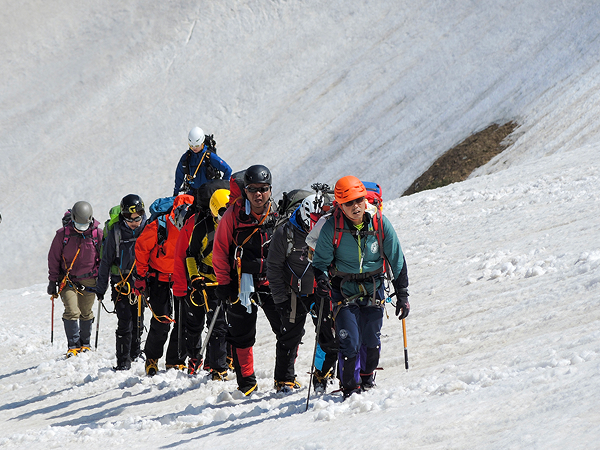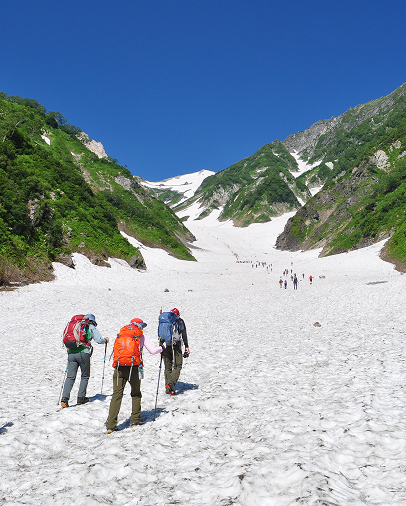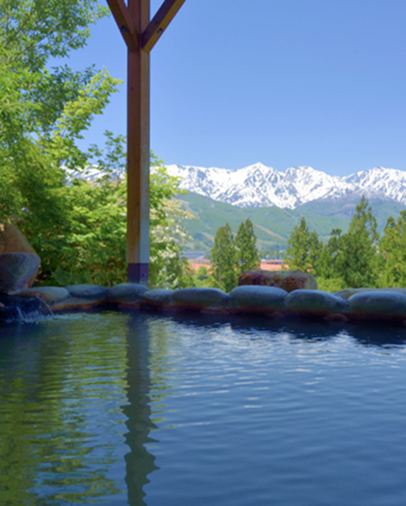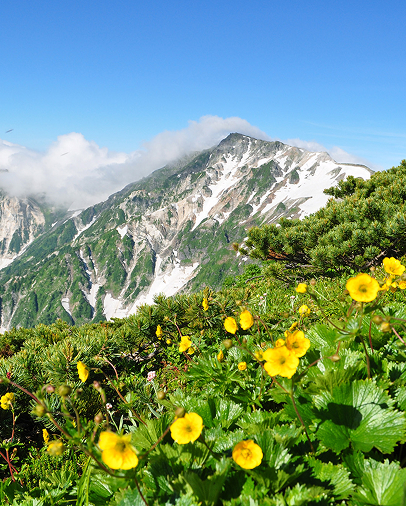登山・トレッキング
スキー場
アクティビティー
Mountain Safety in Hakuba: A Year‑Round Guide for International Visitors

Hakuba’s mountains are awe-inspiring — vast ski resorts, vibrant alpine trails, delicate cherry blossoms, and enchanting fall foliage.
But beauty also demands respect.
The cultural differences in Japan extend beyond removing your shoes before entering a house. In Japan, mountain safety operates differently as well.
Unlike many Western countries, rescue can be costly, signage is limited, and English communication is not always available. A call for help can turn into a disaster when you can’t communicate the issue or even tell search and rescue where you are.
International visitors often take a laissez-faire attitude. They see the cautious approach of ski patrol within the resorts and assume that sneaking off the side is just as safe.
This isn’t to say that people don’t take backcountry safety seriously or fail to plan — but Japan’s systems, expectations, and rescue procedures are different. Understanding those differences before you step off the beaten path can make all the difference.
Disclaimer: This guide is intended for general informational purposes only and should not be considered a substitute for formal training, professional advice, or official rules. Hakuba’s mountains can be treacherous, conditions change rapidly, and rescue services may be limited, costly, and primarily available in Japanese. You are fully responsible for your safety. Always obey local laws, resort rules, posted signs, and ski patrol instructions. Prepare properly and consult local experts before mountain activities in Hakuba.
What Makes Safety in Hakuba Different (and What You Should Know)
Search and Rescue – Cost & Communication
Unlike some countries where mountain rescue is “free,” in Japan, you may be billed for search and rescue operations — particularly if you’ve entered prohibited terrain or gone outside resort boundaries.
However, within ski resort boundaries, many standard rescue services are included as part of your lift ticket, although this coverage can vary by resort and situation. Always check local policies before heading out.
Helicopter rescue, if available, is a highly costly service and is billed directly to you. Weather and terrain can also prevent helicopters from operating, meaning some rescues may rely solely on ground teams, which take longer.
Communication remains one of the biggest challenges. Most dispatchers and signage are in Japanese. When calling 119 (fire/rescue) or 110 (police), start by saying “English, please,” speak slowly, and provide clear landmarks or GPS coordinates.
English-speaking operators may not always be available immediately — patience helps. Having basic Japanese phrases and your location written down in advance can make a big difference.
Mobile reception is patchy, so don’t assume you’ll always have a signal.
Terrain Norms and Local Rules
To many international visitors, Japan’s ski resorts may seem overly cautious with ropes and boundaries. The result? A false sense of safety.
But ducking ropes in Hakuba is not a minor infraction — it can be a serious safety issue.
Under Japan’s Safety Standards for Snow Sports, crossing into closed or restricted areas can lead to fines, lift pass confiscation, and even liability for rescue costs if you require assistance.
Much of Hakuba’s terrain is complex, with steep gullies, glide cracks, and terrain traps that may not be visible from the lift. That ridgeline that looks enticing from the chair can quickly turn into a dangerous situation.
Every year, Hakuba records backcountry fatalities, often involving experienced riders who underestimated the terrain.
Ski patrols operate only within resort boundaries — once you cross that rope, you’re outside their reach. Backcountry rescues typically fall under the jurisdiction of prefectural police or specialized mountain rescue teams, which can take significantly longer to respond.
If you want to explore beyond the resort safely, consider hiring a certified local guide who is familiar with the terrain and conditions.
Plan Smart: Before You Go
Share Your Plan
Always leave your route, start and return times, and emergency contact information with someone you trust — such as your hotel, guide, or a local friend.
Mid-winter last season at 4 PM, the following post appeared in the Hakuba Travel Forum:
“My partner hasn’t come back from skiing the backside of Cortina, and I can’t reach them.”
Luckily, this turned out to be a simple issue with a dead phone battery. But it could have been far worse. A rescue would have taken hours, and someone could have been left out all night.
That small act of sharing your plan can save hours — or even a life.
Pro Tip: Use the YAMAP app (a popular Japanese hiking app) to track your route and send automatic location updates to an email address. But remember: batteries die. Always carry a physical map and compass as a backup.
Have a Japanese Speaker
If you plan to explore Hakuba’s mountains, having someone in your group who speaks Japanese — or a reliable contact you can reach by phone or radio — is invaluable.
Emergency teams primarily operate in Japanese, and miscommunication can slow or misdirect rescue efforts. Being able to explain your location and situation clearly can make the difference between a quick response and a delayed one.
File your Itinerary
Before heading out, submit a Tozan Todoke (mountain climbing registration form).
In Hakuba, filing your backcountry plan provides rescue teams with a starting point in the event of an emergency. Forms are available at access points like Tsugaike and Happo.
Check Local Conditions
Consult the Nadare Avalanche Bulletin for current risk levels (日本雪崩ネットワーク).
Review seasonal alerts, lift operations, and safety information on the Hakuba Valley website.
For multi-day routes or high-alpine traverses, refer to Hakubakan’s lodge and route pages (〖公式〗北アルプス白馬|白馬館).
Gear and Preparation
- Winter: beacon, probe, shovel, avalanche pack — and the skills to use them.
- Spring: waterproof boots, crampons, gaiters, and preparation for unstable, melting snow.
- Summer/Autumn: layers, rain gear, first aid, navigation tools, hydration, and sun protection.
Training & Skills
If you plan to travel in avalanche terrain, complete an Avalanche Skills Training (AST) course. Many Hakuba-based guides and shops offer Avalanche Canada-certified programs adapted for Japan.
Practice regularly, and consider guided refreshers before each season.
Seasonal Strategies: How to Adapt Your Approach
Winter (Dec–Apr)
Avalanches are the primary hazard. Check the Nadare bulletin daily, avoid convex slopes and cornices, and never travel without proper safety gear.
Spring (Apr–Jun)
Melting snow weakens layers, resulting in wet slides and soft slabs. Expect variable coverage and river crossings.
Summer (Jun–Sept)
Afternoon thunderstorms build fast. Heat and humidity increase dehydration risk. Wildlife, including bears and snakes, is active — make noise on trails and respect the natural environment.
Autumn (Sept–Nov)
Days shorten quickly, and early snow or ice can make high trails hazardous. Fewer hikers mean fewer chances of being found if you get lost.
If Things Go Wrong: Response Tips
Don’t assume your travel insurance covers mountain activities. Check for:
- Alpine/backcountry coverage
- Helicopter and multi-day rescue
- Japan-specific coverage
- Medical evacuation abroad
Tools & Resources for English Speakers
- Nadare.jp — Daily avalanche bulletin (日本雪崩ネットワーク)
- Hakuba Valley Website — Route alerts, lift info, safety tips
- Hakubakan.com — Mountain lodges, hut info, route guidance
- YAMAP / Compass — Tracking, route registration, navigation
Final Thoughts: Respect + Preparation = More Fun, Less Risk
Hakuba’s mountains are awe-inspiring when treated with respect. Whether you visit in midwinter or high summer, remember: the terrain rewards humility, preparation, and sound judgment.
Many accidents aren’t dramatic — they happen when someone pushes just a little too far, or neglects to tell anyone their plans.
By sharing your itinerary, checking bulletins, carrying backups, and learning how to communicate in an emergency, you make your trip safer — not only for yourself, but also for the rescue teams who risk their lives to help.
Lastly, respect the mountain environment: pack out your trash, keep noise to a minimum, and tread lightly. Hakuba’s beauty depends on it.




